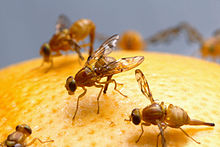
Anastrepha ludens

Anastrepha ludens, the Mexican fruit fly, is a species of tephritid or fruit flies in the genus Anastrepha. Anastrepha ludens, native to Mexico and Central America, is a major pest of agriculture across the Americas. They are highly reproductive and have a long lifespan when compared to other fruit flies. The Mexican fruit fly is an invasive species which was introduced into the US in 1903. In 1903, the first few flies were spotted outside of their native habitat of Mexico and Central America, in small colonies in Texas, which used to be part of Mexico. In 1927, some farmland was found infested with Mexican fruit fly larva. In 1954, the fly spread all around the country, infesting farmland in counties in California, Texas, Florida, and Arizona. The fruit fly is an agricultural pest that has caused 1.44 billion dollars in crop losses. They can infect a wide variety of plants. They prefer to feed on citrus fruits but will also feed on other plants if they are not available. They infect oranges, pomegranate, custard apple, and grapefruit. Males can live for many months and occasionally can live for a full year. Females survive longer than males and can sometimes live for 16 months. The Mexican fruit fly goes through four stages of development completing Holometabolous, or Complete Metamorphosis: egg, larvae, pupae, Adult. The rate at which they mature is directly related to ambient environmental factors such as temperature and humidity. The life cycle begins when the Adult Female lays eggs. The female fly deposits eggs via her ovipositor into the fruit host. The eggs hatch six to ten days later and they enter their second stage of development, the larval stage. This stage lasts for three to four weeks, depending on the temperature and conditions. While inside the fruit, the larvae continue to grow and develop through 3 larval instars. When they have reached optimal size and environmental conditions are right, the mature larvae emerge from the fruit into the soil and begin to pupate. During this stage, the larvae undergo Complete Metamorphosis changing into an adult fly. The adult fly emerges from the pupal casing and the life cycle begins anew. The female fly can lay over 1500 eggs in its lifetime.
